The Reeves-Womack Hoouse in Caldwell, Burleson County. Photo by Sarah Beal
Visiting 14 historic homes across the Bluebonnet region
Stories by Clayton Stromberger and Addie Broyles; photos by Sarah Beal
Sprinkled around the Bluebonnet Electric Cooperative service area are hardy survivors of bygone eras — historic houses that have somehow dodged the vagaries of decay, fire, lightning strikes, changing tastes in home design and the human impulse to scrape away the past to make room for something new and novel.
“Whether it is a farmhouse, a cottage, or an elegant Victorian-style mansion, every house has a story to tell,” says Robbie Moore Sanders, author of the book “Historic Homes of Bastrop, Texas.”
In this issue, we showcase 14 of our region’s historic homes within seven counties where Bluebonnet Electric Cooperative has provided power since 1939. All have state or national historic designations, and they range from rough-hewn cabins built after the Texas Revolution to a grand Main Street mansion befitting the bustling era at the dawn of World War I. These homes offer wonderful examples of old-world craftsmanship and architectural invention.
But most of all, these survivors invite us to delve into stories of the past. Within their walls, you can learn about early settlers arriving after the Texas Revolution, and doctors setting up first-floor clinics in their elegant homes. They teach us about Ulysses Cephas, a civic leader and renowned blacksmith in the historically Black neighborhood of Dunbar in San Marcos, and Wilhelm Neese, an industrious German immigrant who tragically died before he could finish building the stately Warrenton home that still carries his name.
These structures exist today thanks to passionate efforts by communities that refused to let a house fall apart or disappear — whether preserved by family members, local historians or new owners. Some old homes shelter a new generation, while others have become community spaces, museums, city offices or bed-and-breakfasts.
REEVES-WOMACK HOUSE
Caldwell, Burleson County
George Franklin Barber was brilliant at both architecture and marketing. One of the country’s top residential architects in the late Victorian era, Barber sold his home designs through his “The Cottage Souvenir” catalogs. Customers chose from dozens of designs — mostly in the Queen Anne or Colonial styles — and then hired master builders to construct the homes. Around 1895, Caldwell native and successful private banker William Reeves built this elegant, Barber-designed, six-bedroom home out of cypress and pine at 405 W. Fox St., three blocks from the town square. In 1907, it was sold to Civil War veteran Capt. Mansell Lewis Womack, a local business and civic leader, and one-time Burleson County sheriff. The home belonged to the Womack family until 1957. Since 2003 it has been owned by Peggy Gaskamp, whose mother was also a Caldwell native. Gaskamp created a Facebook page to celebrate the house, which has earned state and national historic designations. “This house is a grand ol’ lady,” declares Gaskamp, “and I love her high ceilings, the beautiful wood trim, her grand staircase, and especially her quirkiness!”
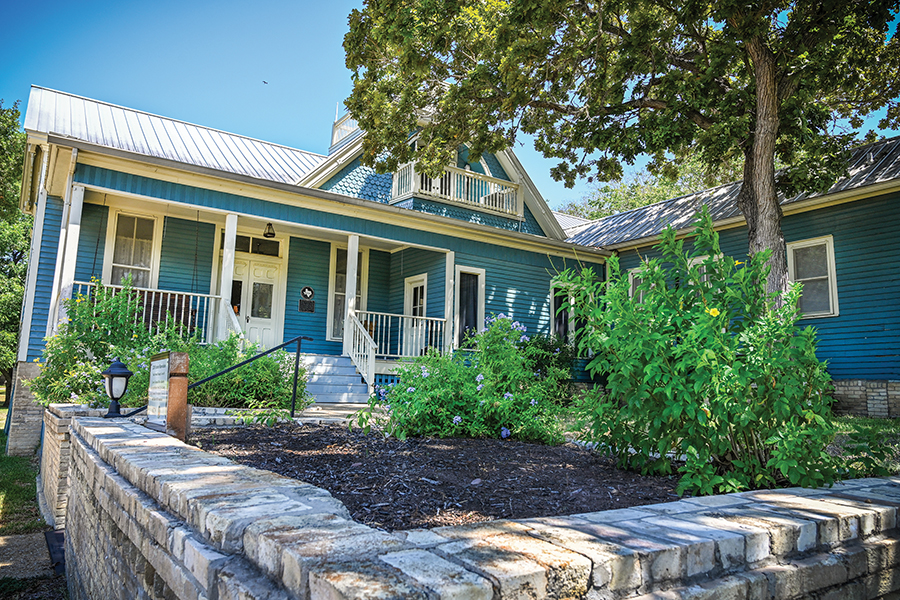
ZEDLER HOUSE
Luling, Caldwell County
The industriousness and ingenuity of German immigrant Fritz Zedler lives on in the Zedler House, adjacent to the Zedler Mill site in Luling. Zedler arrived in Texas at age 12 in 1852 with his family. Thirty-two years later, he moved to Luling and became a prominent citizen, bringing his father’s legacy of German mill work to Central Texas. He joined a group of investors to buy a mill on the San Marcos River, just south of downtown Luling, and was the sole owner by 1888. In 1900, he designed and built near the mill a 10-room, four-porch house with a “widow’s peak.” He lived there with his wife, Louise, their two daughters, and a son-in-law. Into the 1920s, Zedler Mill was the city’s only source of water and power. Cornmeal was ground there until the mill closed in the late 1950s. The home was restored in 1972 and became a Texas Historic Landmark two years later. It was purchased by the City of Luling in 2002 and renovated as a site for weddings and gatherings. Rooms, suites or the entire house can be rented. The Zedler Mill Museum just across the road is open daily and free to the public.
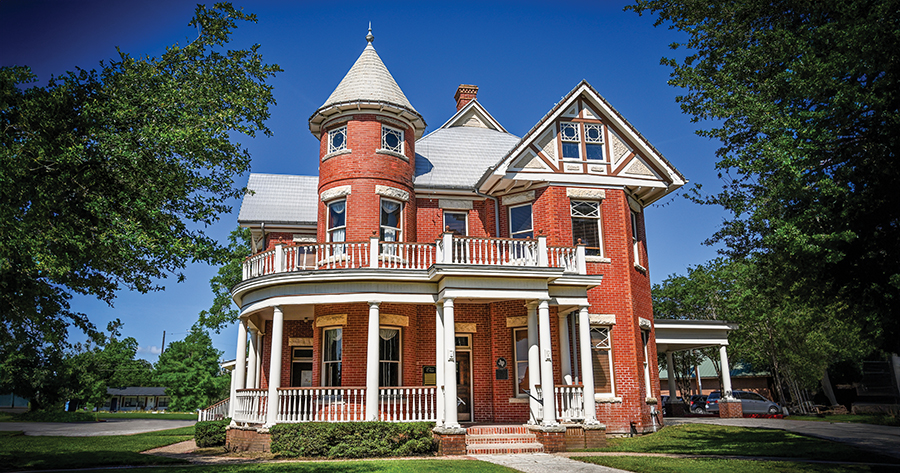
DR. I.B. NOFSINGER HOUSE
Elgin, Bastrop County
This elegant Queen Anne home — made of Elgin pressed brick and adorned with touches such as half-timbering and a turret — has long played a role in the civic life of Elgin. The house, at 310 N. Main St., was built in 1906 by a Kentucky-born doctor, I.B. Nofsinger, and designed by his wife, Mary, a pharmacist. They operated a medical practice on the first floor. The home remained in the Nofsinger family until 1978, and it later became the home of Elgin Savings and Loan. In 1991, the city purchased it and converted it into a unique city hall. The wraparound porch serves as a swearing-in spot for city officials and occasionally as a stage for local dramatic productions. The house has both state and national historic recognition. Many interior features, from doors to fireplaces, are original. “All the architectural elements and the big windows make it a really nice place to have an office,” says Amy Miller, Elgin’s community services director. From its days as a bank, it still has a drive-through window, now used by residents pulling up to pay their utility bills. Elgin City Hall is open to the public 8:30 a.m. to 4:30 p.m. weekdays.
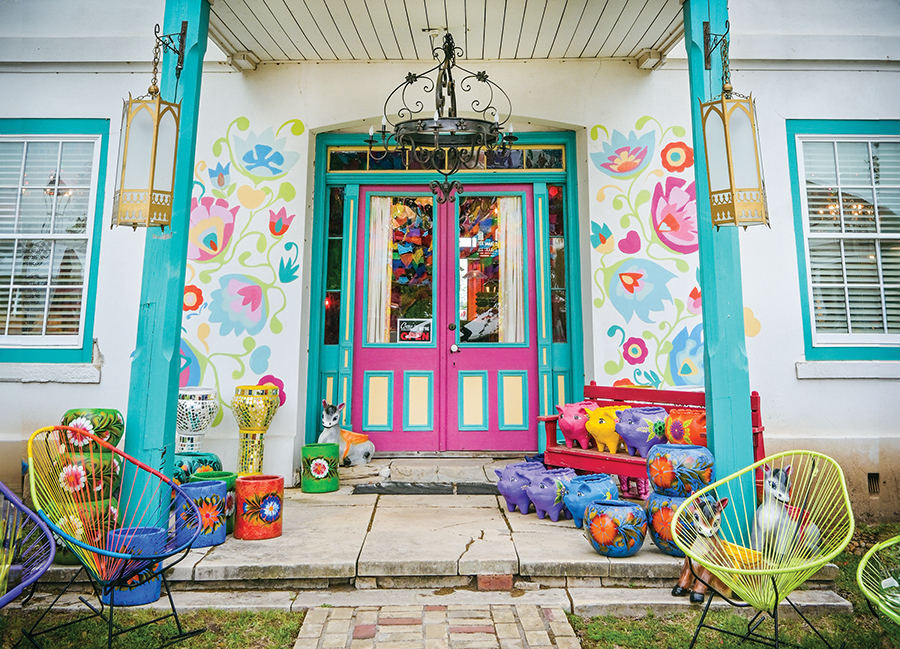
WILHELM NEESE HOUSE
Round Top, Fayette County
When the Original Round Top Antiques Fair is in full swing, State Highway 237 from Warrenton to Carmine becomes a swirl of signs, storefronts and thousands of bargain-hungry tourists. One shopping destination stands alone in its historic grandeur: The Wilhelm Neese House in Warrenton, which beckons with its festive exterior of bright paint and floral patterns. Neese, who left Germany for Texas in 1847, opened a general store in this community and sold cotton. In 1869, he began building a grand home for himself and his wife, Louisa, using stone from a nearby quarry. Neese was killed in 1872 in a confrontation with a thief at his store, but his unfinished home was completed by local merchant F.G. Cordes in 1894. The house was known for its ballroom upstairs, the site of parties and performances. Since 2016, it has been owned by Tom and Diane Conlee, who brought colorful whimsy to the exterior. Each spring and fall, during the antiques events, it becomes Punkie’s Place, Diane’s shop for handmade goods and antiques. “My husband loves the house for the history,” she says, “and I love it because it’s fabulous!” The house is listed on the National Register of Historic Places as the William Neese Homestead.
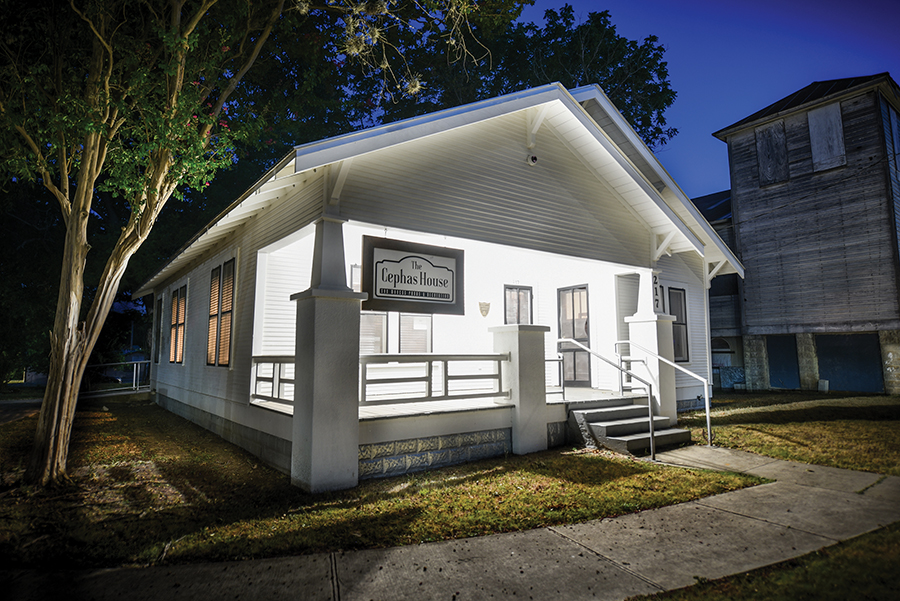
CEPHAS HOUSE
San Marcos, Hays County
Lifelong San Marcos resident Ulysses Cephas was the area’s most renowned blacksmith and shoer of horses for decades. He was also a builder and owner of rental houses, a deacon and choir leader at First Missionary Baptist Church, and the organizer of the San Marcos Independent Band, which performed around Central Texas. Cephas was born in 1884 in San Marcos to former slaves Joe and Elizabeth Cephas. He learned his trade from his blacksmith father and eventually owned his own shop at 224 Guadalupe St. He and his wife, Cora Willie Cephas, raised a family in this handsome, sturdy early-1900s home on what is now West Martin Luther King Drive. They lived in the heart of the Dunbar neighborhood, then a thriving community with many Black-owned businesses just south of downtown San Marcos. Hays County preservationist Johnnie Armstead persuaded the city to purchase the Cephas home to renovate it as a community center, which it has been since 2013. The Calaboose African American History Museum across the street tells the story of Dunbar, now a city-designated historic district.
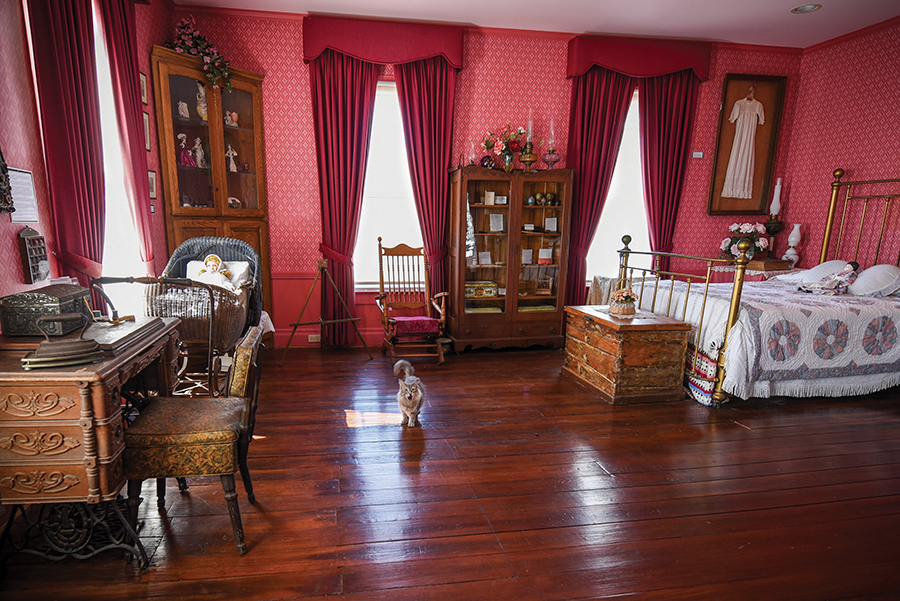
SCHUBERT-FLETCHER HOUSE
Giddings, Lee County
After the last residents move out, some old houses have the good fortune to be reborn as museums, becoming resources for the public to share and enjoy. “Historic houses have a lot of character,” says Kelita Thomas, who counts herself fortunate to work in the Schubert-Fletcher House in downtown Giddings, 183 E. Hempstead St. Thomas, tourism director for the town’s Chamber of Commerce — which has its offices in the old home — is always ready to guide visitors through exhibits of the Lee County Museum in the house. “You’ve got beautiful wood floors, amazing craftsmanship, high ceilings,” Thomas says. “It feels very much like home to work here.” Merchant August Schubert built the two-story house in a Greek Revival style in 1879. Antique furnishings, including a treadle sewing machine and a wicker pram, fill the second-story room, pictured. It is also a favorite hangout for Meow, the resident cat and “pampered lady of the house,” Thomas says. Schubert sold the house to Concordia Lutheran College in 1894, and state legislator Baylis J. Fletcher purchased it in 1900. Fletcher family members lived there until the mid-1980s. They donated it to the Lee County Heritage Society, which passed it along to Lee County in 2017. The house is on the National Register of Historic Places and is open for tours during weekday Chamber of Commerce business hours.
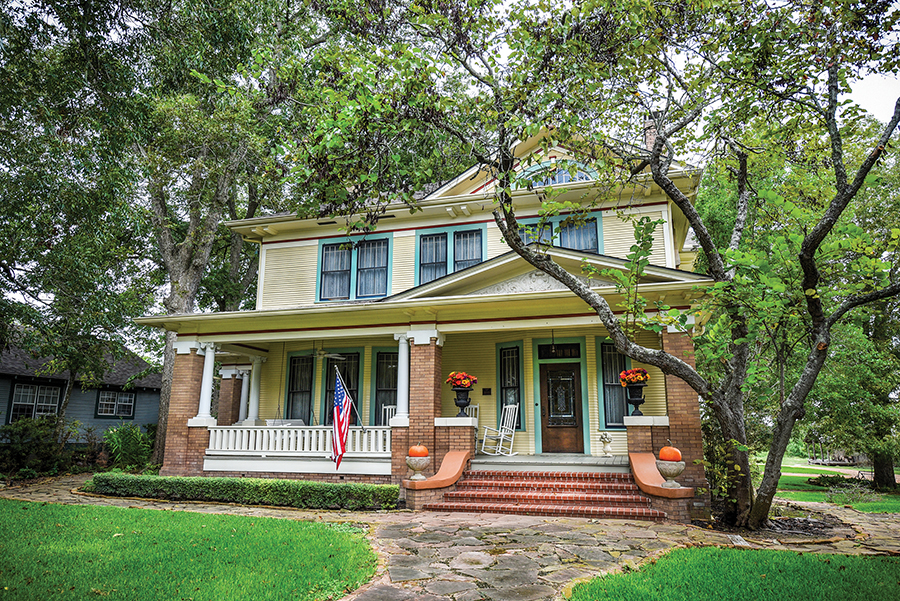
J.J. SHAVER HOUSE
Chappell Hill, Washington County
As the story goes, the first telephone in Chappell Hill was installed on the second-floor landing of the house on Main Street. J.J. Shaver, the first president of Farmers State Bank, built this two-story, asymmetrical house with a wraparound porch in 1914. It blends Prairie, Craftsman and Greek Revival architectural styles. Shaver’s descendants — including Bernice Shaver, who ran the now-closed Chappell Hill Drug Store — lived in the house until 2001. Kathy and Clay Parker have been the guardians of this treasure in Chappell Hill’s Main Street Historic District, adding only a functioning kitchen and a bathroom downstairs. Not long after they bought the house, the Parkers found its original blueprints in a closet: They framed them, and today the plans hang in the stairwell. Although it has two restored bedrooms, the couple use the home as an office, driving in from their ranch outside of town each workday to run the family business. Kathy said they enjoy pecans from the trees in the yard in the fall and, in spring, the white blooms of the massive magnolia on the north side of the house. The tree nearly dwarfs the residence. The Parkers also share the elaborately decorated house with visitors who take the Chappell Hill Garden Club’s annual Christmas Home Tour each winter.

E.S. ORGAIN HOUSE
Bastrop, Bastrop County
It was a very big wedding present — a brand-new, 2½-story Classical Revival-style home, with fluted Doric columns and three coal-burning fireplaces, at 1704 Main St. in Bastrop. The house, completed in 1915, was a gift from Capt. Benjamin Darby (‘‘B.D.’’) Orgain — former county attorney and a founder of the First National Bank in Bastrop — to his son Elbert and daughter-in-law Louise. The Orgain family owned the home until 1974. Since then, a succession of private owners have cared for and restored the home, here decorated for the Christmas holidays in 2022. It was the setting for the 2013 holiday-themed movie “Angels Sing,” starring Harry Connick Jr., Lyle Lovett and Willie Nelson. It is one of three historic homes in Bastrop with the Orgain name, along with the B.D. Orgain House at 1508 Church St., built in 1888, and the house at 602 Cedar St., built before 1858, that was the longtime residence of Sarah Jane Orgain. She was an esteemed teacher who married Edmund Orgain, Benjamin Orgain’s brother. “There are over 80 homes in Bastrop listed on the National Register of Historic Places, and this is one of them. It’s beautifully restored and in pristine condition,” says Robbie Moore Sanders, author of the book “Historic Homes of Bastrop, Texas.”
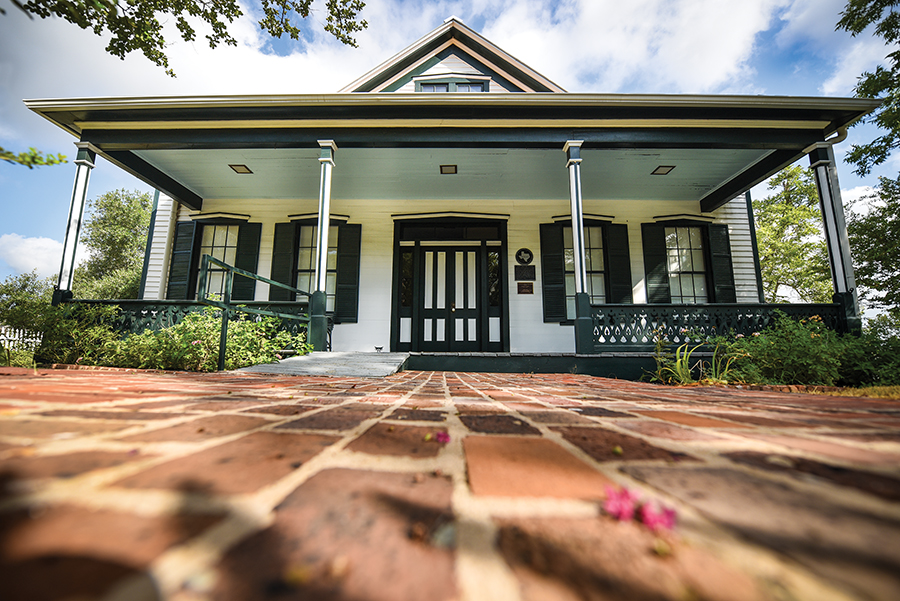
THOMAS KRAITCHAR JR. HOUSE
Caldwell, Burleson County
Does Ella Kraitchar still pace the wooden floors of the house where she was born and spent most of her life? Footsteps have been heard more than once in the old home in the center of Caldwell, at 203 E. Buck St. Some say lights are turned on when no one is there. “I’m a little skeptical about ghosts,” says Caldwell resident Linda Chamberlain, a member of the Burleson County Historical Society, which owns the Victorian cottage-style home made of cypress. She opens the home for tours, “but, I assure you, I’m not going in the house alone after dark.” Merchant Thomas Kraitchar Sr. built the home in 1891 as a wedding present for his son Thomas Jr. and daughter-in-law Mary. Ella Kraitchar, their last surviving child, moved out of the home in the 1970s. Period furnishings give visitors the feeling of stepping back in time. The house became a Texas Historic Landmark in 1983 and is also on the National Register of Historic Places. Caldwell Elementary School third-graders visit Kraitchar House every year. It is open during Caldwell’s Kolache Festival and Christmas homes tour, as well as for tours on request.
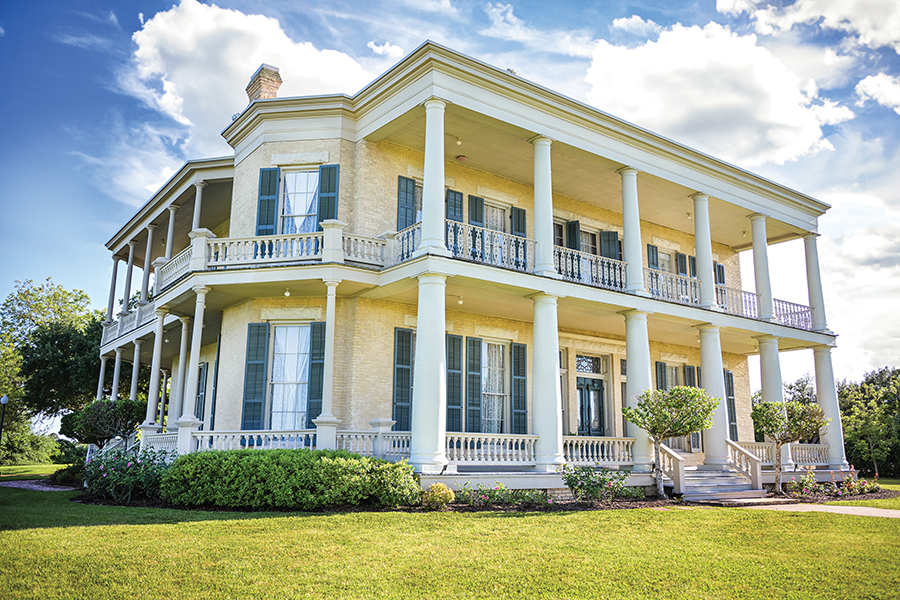
GIDDINGS STONE MANSION
Brenham, Washington County
This stately Greek Revival mansion south of downtown Brenham, completed in 1870, was built on elevated land to evade mosquitoes, which had caused a recent yellow fever epidemic. It was the home of prominent Brenham banker, lawyer and landowner Jabez “J.D.” Giddings and his wife, Ann. J.D. Giddings came to Washington County in 1838 from Pennsylvania to claim land given by the Republic of Texas to the heirs of his older brother, Giles Giddings, who was mortally wounded at the Battle of San Jacinto. The nearby town of Giddings was named for the family, thanks to their role in bringing the railroad to the region. The home, later owned by daughter Mary Louise Giddings Stone, has 11 rooms and a five-bay, two-story front porch with Doric columns. Subsequent remodeling made it the first house in Washington County with indoor plumbing. Mary Louise and her descendants lived in the home until the 1970s. In 1976 it was donated to the county’s heritage society and in 1991 it became a Texas Historic Landmark. Today, it is a popular site for weddings and events.
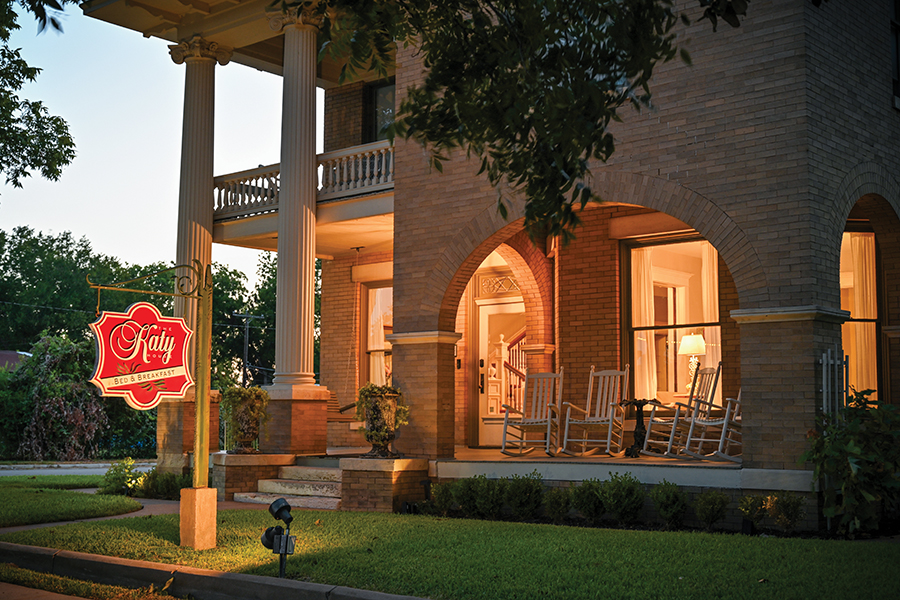
KATY HOUSE
Smithville, Bastrop County
Many longtime Smithville residents still know the grand home at 201 Ramona St. — home of the Katy House Bed & Breakfast since 1994 — as “Dr. Stephens’ place,” even though its Texas Historical Marker refers to it as the Chancellor House. J.D. Stephens was a company doctor for the Missouri-Kansas-Texas Railroad, known as the M-K-T or “Katy” line. He bought the home in 1941 after the death of its original occupant, local real estate developer and grocer J.H. Chancellor. The home’s first floor served as Dr. Stephens’ clinic through 1968. Built around 1909, the home is distinctive for its Italianate styling, Classical Revival balustrade, fluted columns and arched porch. Tiffany and Joe Prior bought Katy House in December 2019. “I just fell in love with everything about it,” Tiffany Prior says. Six rooms are available for guests, and they wake up to something special — Katy House was honored for the “Best Breakfast in Texas” in 2022 by the Texas Bed & Breakfast Association. In the backyard, you can still find a reminder of earlier occupants: the minnow tank built for Dr. Stephens’ wife, Neva, who was an avid fisherwoman nicknamed “Pete.”
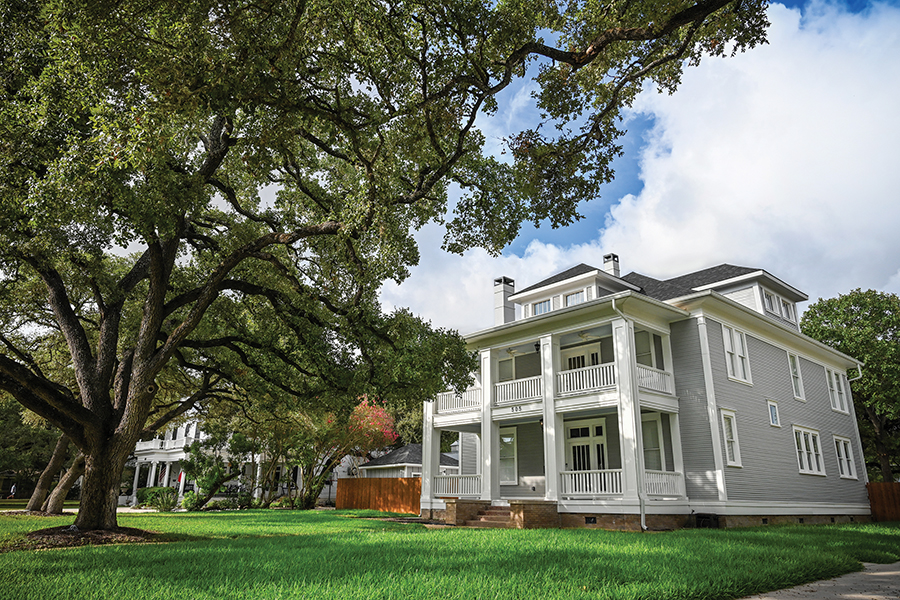
CARDWELL HOUSE
Lockhart, Caldwell County
The man who built the white house with the columns at 505 S. Main St. in Lockhart never had the opportunity to live in it. John M. Cardwell moved to Caldwell County in 1856, when he was 18. After the Civil War, he returned to Lockhart to be with his wife, Mattie, and he became a merchant with a store on the courthouse square downtown. In 1917, he had the two-story Classic Revival-style home built, but he died that year. His wife lived there until 1944. The house features four columns, 11-foot ceilings, five fireplaces and a second-floor balcony. Shaded by towering oak trees, Cardwell House was originally restored by Charles and Carol Haynes in 1979, and has had several owners. It first got air conditioning in 2012. Cassie Epperson-Jones, who grew up on the Texas Gulf Coast admiring Galveston’s grand historic homes, bought the house in 2016 to raise her school-aged children. The family converted the carriage house into a living room with a modern bathroom, put in a driveway and transformed the back porch into a laundry room. “When my daughter was in junior high, the kids used to tease her about living in a mansion,” Epperson-Jones said. “I told her, ‘Nobody who shares a bathroom lives in a mansion.’ ”
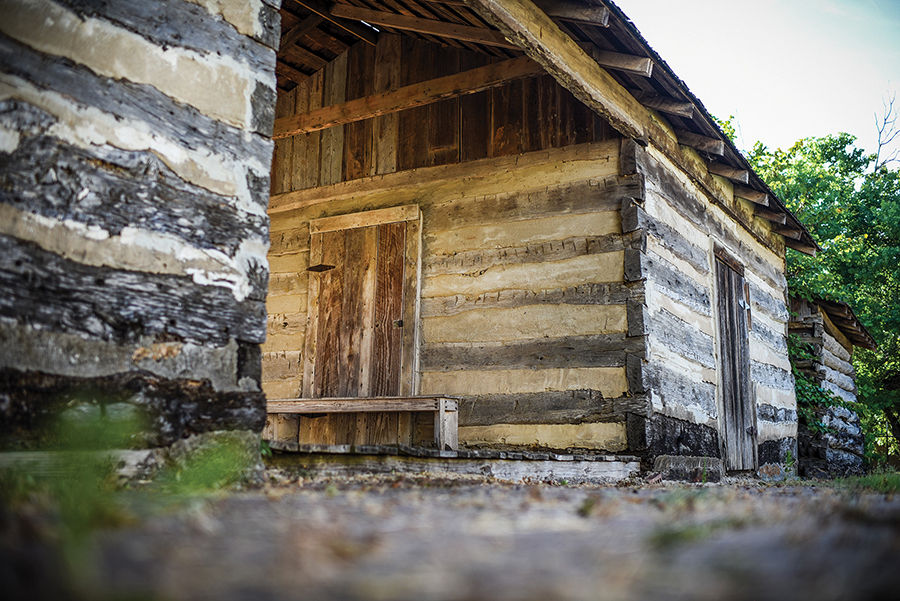
LEXINGTON LOG CABINS
Lexington, Lee County
In our nation’s bicentennial year of 1976, the citizens of Lexington — from history buffs to high school students — pitched in to carefully disassemble and relocate two pioneer cabins from the countryside in northern Lee County to the town square. Originally built several miles apart around 1850 by settlers who came to farm or ranch on the area’s open range, the two-room cabins were made with hand-hewn oak beams and had rugged stone fireplaces. They were built in the traditional dogtrot style, with a center breezeway for hot summer afternoons. Today the cabins are cared for by the nonprofit Lexington Log Cabins and Heritage Center, which opens them for school group visits and tours, and during the Lexington Homecoming festival each May. Graham Brown’s family owned one of the cabins when he was young, and the Lexington native remembers playing in and around it in the early 1950s while grownups harvested peanuts nearby. “I would sit on that hill and look around and think about the old days,” Brown recalls. You can think about the old days, too, on a visit to the cabins and the accompanying Heritage Center, which features exhibits on Lexington’s history.

N.W. FAISON HOUSE
La Grange, Fayette County
After moving to Fayette County from Houston two decades ago, author Marie Watts became intrigued by an African American cemetery near her home in Muldoon. She learned the land for the cemetery had been donated after the Civil War by Nathaniel Faison, a wealthy white La Grange merchant and land speculator originally from Tennessee. In 2005, while flipping through old property documents with local historian Janelle Dupont at the Fayette County clerk’s office, they found a deed signed by Faison in 1870 leaving his home to his Black housekeeper, Louisiana Brown. He died later that year. “She is one of the first freedwomen in the state of Texas to own property,” says Watts, vice president of the Faison Preservation Society, which owns the home and runs a museum there. Established in the 1960s by the La Grange Garden Club, the house, at 822 S. Jefferson St., introduces visitors to the rich, complex stories of Brown, the Faisons, and race relations in the area after the Civil War. Listed on the National Register of Historic Places, the house is one of the oldest in Fayette County. Construction began in 1841. It has original furnishings and household items from the late 1880s.
How to visit area historic homes
Four of the homes in this calendar are open to the public as museums:
- The N.W. Faison House, 822 S. Jefferson St., La Grange (faisonhouse.org)
- The Schubert-Fletcher House, 183 E. Hempstead St., Giddings, site of Lee County Heritage Center (giddingstx.com)
- Kraitchar House, 203 E. Buck St., Caldwell (caldwelltx.gov, click Discover Caldwell, then Museums)
- Lexington Log Cabins and Heritage Center, 524 Fourth St., Lexington (hours vary, call Trudy Holland, 512-496-2779, for information)
You can also visit:
- Nofsinger House, 310 N. Main St., Elgin, open for City of Elgin business (elgintexas.gov)
- The Giddings Stone Mansion, 2203 Century Circle in Brenham, open for special events (giddingsstonemansion.com)
- Punkie’s Place, at the Neese House, 4218 S. H. 237 in Warrenton, open during the Round Top Antiques Fair (punkiesplace.com/ location and roundtoptexasantiques.com)
- Cephas House, 213 Martin Luther King Drive, San Marcos and the Calaboose Museum across the street (calaboosemuseum.org)
You can spend the night at:
- Katy House Bed & Breakfast, 201 Ramona St., Smithville (katyhouse.com)
- Zedler House, 1115 S. Laurel Ave., Luling (cityofluling.net, search for Zedler)





